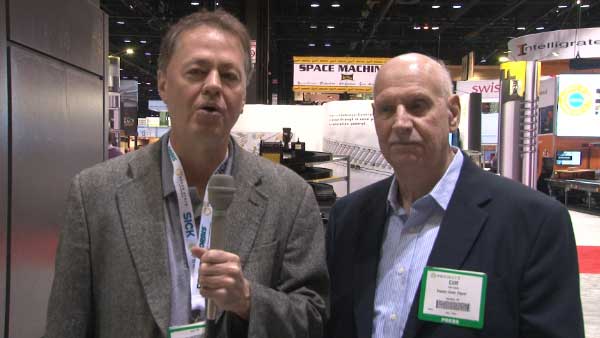 |
April 2, 2015 - Supply Chain Flagship Newsletter |
 |
 |
 |
|
||||||||||||||||||||||||||||||||||||||||||||||||||||||||||||||||||||||||||||||||||||||||
First, I will just briefly summarize two new solutions that were mentioned last week, as illustrative of the trends in automated case and piece picking. The first was a new robotic case picking system from Daifuku. What makes it noteworthy is that it uses a 3D vision system to select cartons off a pallet for order picking or depalletization. The technology enables the robot to do so with no prior knowledge of the pallet's carton configuration, unlike most existing systems. So, it could work on an incoming mixed-SKU pallet from a supplier for unloading on to a conveyor. Put on a mobile platform, the system could unload cases from a container or trailer - or maybe even move down an aisle of carton flow rack and pick cases. Wow.
Dematic added a piece-picking robot to its Rapid Pick system, which uses its multi-shuttle technology to deliver totes to a work station, where until now a human selected items to go into shipping cartons, as one shuttles zooms away and another arrives. This year, a robot was doing that job, picking at a rate of 750-1200 items per hour. The system is deemed developmental at this stage, but I expect will see the light of day commercially soon. The coolest new solution at the show to me was technology from a company called GrabIt. Developed at Stanford, the technology uses electrostatic energy - static electricity, like rubbing a sock so it sticks to a wall - to address a broad range of materials handling applications. GrabIt has created a very thin and flexible material with circuit patterns on it, which goes underneath some substrate - like a conveyor belt - so that when charged it controls a carton or item.
So, for example, it can move even heavy cartons up a very steep incline without them sliding back - perhaps eliminating the need for an expensive vertical spiral conveyor in some systems. It can also somehow brake cartons coming down a ramp by locking the rollers - this was very cool. It put the circuit material under what you might call fabric fingers and easily reached out and grabbed an apple, and picked up a circuit board with zero pressure being applied in another application, etc. Don't know where this is going to go, but Cliff and I believe there is a lot of potential.
Called "StuffIt" and "DeStuffIt," the solutions might give a nice boost to productivity and unquestionably improve worker ergonomics in a big way. If you deal with floor-loaded containers/trailers, the system is definitely worth a look.
Just to break things up a bit, I'll switch over to the software side for a minute, as Softeon announced its Plan to Fulfill solution. Hard to describe in just a few sentences, P2F combines demand sensing capabilities for short to mid-term forecasting and uses that to create detailed inventory and replenishment plans, all the way through to actual fulfillment. It is being used at Sony DADC and a handful of other companies.
It is noteworthy, I think, for enabling the trend towards tighter integration of planning and execution, and I liked its "milestone management" capabilities for coordinating new product introductions and promotions management.
Honeywell, under its Vocollect brand, unveiled an interesting set of analytic applications under the banner of "Operational Acuity." One was a form of labor management system, which featured a very cool new age, "app" looking user interface, and while it may not provide all the functionality of a full blown LMS, it might get you a good chunk of the way there with a lot less effort.
The other was a form of vehicle management system. Honeywell says existing systems are often overkill, and provide a lot of functionality companies don't really use. Honeywell claims to have thought all that through to develop more a appropriate solution. The system leverages the truck-mounted RF terminals already in place on most equipment, to which it adds some sensors and a front and back video camera - all of which it says can be installed in 20 minutes per truck. Besides analytics around truck movement, productivity and behavior, if say a driver hits a bit of racking, a supervisor immediately receives a smart phone alert, with video of the accident itself. That's cool - there is more I am leaving off due to space constraints.
A company called pcdata offered a form of "smart glass" solution which can obviate the need for expensive hardware in pick- or put-to-light applications. It isn't truly a smart glass - rather, the headset uses regular safety glass lenses, through which a very small projector actually displays images to a DC worker.
So, for example, a worker simply looks at a 2D bar code, and the system displays how many units to put into that tote or carton - no light-specific hardware is used at all. I tried the system myself, and will say it would take a bit of getting used to for sure, but it's a very interesting approach, and of course would be very flexible versus a hardware-based system.
And of course, what would a logistics show be right now without at least one drone-based system? A company called PINC Solutions offered just that, with a system that uses a small drone for yard management. The idea is that the trailers would be equipped with RFID tags, and several times throughout the day the drone with a reader would fly around the yard and make sure everything is where it is supposed to be, and update the YMS with any new information.
PINC said it is also piloting (no pun intended) a system that would work similarly for taking inventory inside a retail DC. Pallets in this case would be RFID-tagged, and the system would do periodic cycle counts via drones flying up and down the aisles. We reported on another company a few months ago that wants to do the same thing at the item level inside a retail store. So if you are doing some shopping and see a drone fly up next to you, it's not spying on you personally, just doing a bit of cycle counting. We think.
I am out of space. Other interesting solutions you will find on the videos include a new high density carton storage system using a AGV that not only brings products to and from the storage unit but also moves within it, from Hi-Tech Robotic Systems; a new robotic case picking system from System Logistics that also used vision to identify the package configuration of each case and then auto selects and installs the right tool for the end of the robotic arm; a discussion of the difference between materials handling simulation and "emulation' that it worth understanding with Demo3D; and SSI Schaefer's approach to a goods-to-person shuttle system and "3D Matrix' storage technology.
Again, the two videos highlight all these and more.
Any reaction to our ProMat 2015 review? Were you there? What did we miss? Let us know your thoughts at the Feedback button or section below.
|
|||||||||||||||||||||||||||||||||||||||||||||||||||||||||||||||||||||||||||||||||||||||||
|
|||||||||||||||||||||||||||||||||||||||||||||||||||||||||||||||||||||||||||||||||||||||||
|
|||||||||||||||||||||||||||||||||||||||||||||||||||||||||||||||||||||||||||||||||||||||||
|
|
|
YOUR FEEDBACK
We're frankly backed up on a lot of feedback lately (that's great), but in keeping with the theme this week we're going to jump ahead with a few of the many nice emails we received for our ProMat coverage and videos.
Keep 'em coming!
Feedback on SCDigest ProMat 2015 Coverage and Videos:
Many thanks for your column and the Day 1 and Day 2 videos! It was a busy week and clearly the most successful PROMAT yet. You helped me (and others, I'm sure) to fill in many of the highlights missed in spite of valiant attempts to cover the 800+ exhibits. John M. Hill
|
||
Great work on the full review. I really enjoyed the end of day videos from you and Cliff. It covered a lot that I didn't get to see while I was in our booth. You're a great set of eyes and ears for everyone who didn't get a chance to walk the full show. Thanks. Ryan P. Sheehan
|
||
I agree with your statement regarding automation. There was a significant increase in both the quantity and flexibility of the goods to man technologies. As high quality labor gets harder to find and more expensive is there any other option?
Interesting that you noted that H2 fuel cells had a reduced presence at the show. I saw it the other way. The leader, Plug Power, was in the portion of the show you didn't get to, NMHG is getting into the fuel cell business through Nuvera acquisition and more hydrogen suppliers were there than I've ever seen before. One other interesting new twist was multiple vendors pushing Lithium ion batteries for any size lift truck. I'm not sure they are ready for full scale implementation but this could hold promise if they live up to their claims of significantly longer run times, super fast recharge rates and longer life with almost no maintenance. Could be a tough sell since they are bypassing the lift truck dealers for sales/service but time will tell. Ronn Cypher |
||
Thank you for your outstanding ProMat coverage. Your video summaries are simply a treasure and obviously not replicated by any other publication in the industry. Congratulations to you and Cliff, for being able to identify the key themes and find and well describe the interesting new solutions you found. We want more! David Keller Newport Beach, CA |
||
| Great summary of the show. Sorry I don't have the resources to attend myself.
A question: you mention that RFID solutions were "very hard to find." That is interesting in itself -- your thoughts on why? Regarding RFID, I have been counseled for years that soft goods are a good fit, and hard goods (steel castings, bearings, fasteners, etc.), particularly in a large parts warehouse (think a mining MRO environment) would be a significant challenge. Have you or Cliff seen anything that could change my opinion? You did say that "technology barriers are almost gone." I welcome your feedback. Steven R. Murray
Editor's Note: I just believe that logistic solution companies - notably WMS providers - are not seeing any demand, almost none at all, at least in the US. Somewhat different in Europe and even parts of Asia. Conversely, many of the materials handling companies are moving to vision based systems I think the technology is addressing the issues with metals, but am not real up to speed on that. There is a lot of activity in item level apparel, and as with bar codes think eventually it will move its way back up the supply chain Dan Gilmore
|
SUPPLY CHAIN TRIVIA ANSWER
Q: Match these well-known supply chain academics to their universities: David Simchi-Levi, John Langley, Hau Lee, Doug Lambert, Karl Manrodt: Ohio State, MIT, Penn State, Georgia Southern, Stanford
A: Simchi-Levi/MIT; John Langley/Penn State; Hau Lee/Stanford; Doug Lambert/Ohio State; Karl Manrodt/Georgia Southern
| © SupplyChainDigest™ 2003-2015. All Rights Reserved. SupplyChainDigest PO Box 714 Springboro, Ohio 45066 |
POWERED BY: XDIMENSION
|






 In the "why didn't I think of this first" category, a company called Engineered Lift Systems and Equipment from Canada featured a mechanical assist system for loading/unloading cartons from a container or trailer. It's really just a powered conveyor apparatus that can be moved very flexibly up and down, left and right, from the top most level all the way down to the lowest tier on the container floor. When unloading, for example, all the worker has to do is slide cartons from the container on to the belt and off they go, without needing to actually lift each box. Same holds true in reverse for container/trailer loading.
In the "why didn't I think of this first" category, a company called Engineered Lift Systems and Equipment from Canada featured a mechanical assist system for loading/unloading cartons from a container or trailer. It's really just a powered conveyor apparatus that can be moved very flexibly up and down, left and right, from the top most level all the way down to the lowest tier on the container floor. When unloading, for example, all the worker has to do is slide cartons from the container on to the belt and off they go, without needing to actually lift each box. Same holds true in reverse for container/trailer loading.

